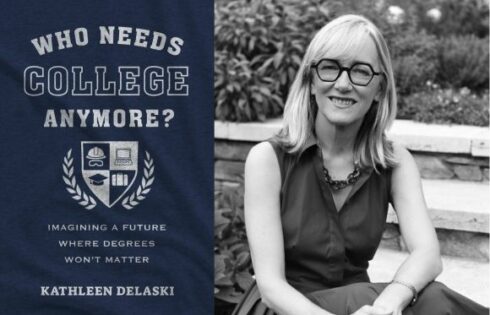
Universities ‘don’t care about trying to put people in jobs’ or setting them up ‘for success,’ report co-author says
Ohio’s higher education system urgently needs reform to tackle rising costs, student debt, and underperforming programs, according to a recent report by a conservative Ohio think tank.
The Buckeye Institute report highlights issues with administrative funding, degree requirements, tenure policies, and occupational licensing. It also states that administrative spending “bloat” has increased the overall cost of a college degree.
Co-author Greg Lawson told The College Fix during a phone interview that a leading cause of these issues is the federal government subsidizing universities.
Lawson said that the federal government’s involvement in the “subsidization game” through student loans has contributed to the rise in administrative spending from 1976 to today.
These student loans “are not dischargeable by bankruptcy, so universities get the money up front,” Lawson said. “They don’t care about trying to put people in jobs and making sure that people are set up for success.”
He linked the system’s expansion to a disconnect between the federal government’s spending incentives and those of colleges and universities.
As the government pours in more money, more programs are created that need funding and more administrators are hired to run the programs—increasing administrative bloat.
From the government’s perspective, “if there’s a problem with the debt load that a student has, well that becomes that student’s problem with Uncle Sam down the road,” Lawson told The Fix.
Compounding this issue, Ohio currently spends over $2 billion subsidizing higher education, which community colleges only receive a quarter of, despite teaching over 35% of the state’s students, according to the report.
Further, “Ohio’s funding formula relies heavily on outmoded graduation rates with little regard for post-graduate earnings or success,” the report states.
“If the state continues in its misguided preference to fund schools rather than students, policymakers should at least reform the state share of instruction (SSI) subsidy to prioritize post-graduate metrics, such as debt-to-income ratios, job placement statistics, and loan repayment rates,” it states.
One such example of misguided preferences is the Ohio College Opportunity Grant Program, a state-funded financial aid initiative. It is currently “broken” because it prevents some students from obtaining a community college degree by funneling most money into four-year institutions, Lawson said. OCO Grants do not apply to community college students.
Reached by The Fix, Ohio Department of Higher Education spokesperson Jeff Robinson stated, “Given the fact that we are in the midst of budget development, we would not be able to comment on the report at this time.”
MORE: Ohio law schools end race-based programs after think tank probe
Lawson proposed barring students whose tuition is covered by a Pell Grant from also receiving an OCO grant. This could allow community college students to receive OCO Grants, helping cover outside expenses that might hinder their ability to pay for a college education.
This administrative bloat doesn’t just inflate costs. It also undermines the benefits of tenure, according to the report.
Lawson said that when appropriately taken advantage of, tenure has long-term benefits, allows free and innovative thinking, and expands various fields of knowledge.
However, universities hire “insulated” professors who are unwilling to properly teach students, work with students or “produce” anything in their field of knowledge. Students then end up learning from lower-level professors or even teaching assistants, especially in entry-level courses, he said.
Tenure is meant to be a protection, but not an allowance, Lawson said. He believes that a reevaluation of tenure should not be “unduly punitive,” and might look like institutions organizing a sort of “tenure review track” for faculty members who consistently receive poor reviews.
This lack of quality education exacerbates broader issues, as one of the most pressing challenges for recent college graduates in today’s job market is gaining the right skills to be hired as the economy shifts toward a tech-centric future, Lawson told The Fix.
“Ohio has not really fully adjusted to these changes,” Lawson said, adding that other states face similar struggles. He suggested updating workforce training to align with the current economy and resizing higher education infrastructure to reflect declining demographic trends.
Furthermore, unnecessary bachelor’s degree requirements pose a “holistic, broad-based challenge,” as employers have been recently seeking candidates with a “skills-based background” rather than just a degree, he said.
“We have a deficit of skilled trades,” or roles that don’t necessarily require four-year bachelor’s degrees, he said.
In the past, the four-year degree signaled to employers that individuals had the necessary qualifications for a job. These days, individuals have access to more methods for acquiring skills that some employers are looking for.
Lawson said that credential inflation has led to employers requiring applicants to have higher degrees for jobs than in the past. This became a “lazy way” for them to “weed out” candidates upfront without doing the work to determine if they’re a good fit.
However, businesses are now experiencing labor shortages. Companies need to assess what they truly need in employees and avoid inflating requirements, Lawson said.
The report suggests eliminating unnecessary bachelor’s degree requirements for state employment and having Ohio regulatory agencies review job demands to ensure they match the experience and training required of applicants.
MORE: 80 colleges could close in next 5 years: Federal Reserve study
IMAGE: University_of_College/Shutterstock
Like The College Fix on Facebook / Follow us on Twitter






Please join the conversation about our stories on Facebook, Twitter, Instagram, Reddit, MeWe, Rumble, Gab, Minds and Gettr.